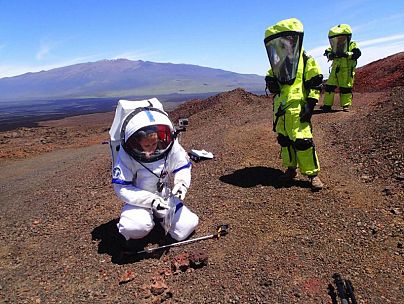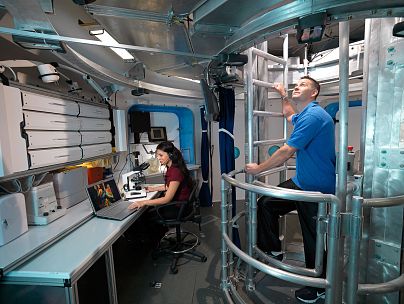NASA has a plan to help spaceflyers cope with profound isolation during the two-year round trip.
For the lucky astronauts on a mission to Mars — the kind that NASA hopes to mount in the 2030s — there will be no shortage of things to worry about during the two-year round trip. A meteoroid could puncture their spacecraft. A solar flare could dose them with dangerous radiation. An Apollo 13-like explosion could send them careening off course or cause their life-support equipment to break down.
But one of the biggest concerns for Mars-bound spacefarers might be preserving their sanity, and that of their crewmates, while they're cut off from every single other person on Earth. NASA's current concept for a Mars Transit habitat is just 28 feet high, 28 feet wide and 17 feet long, with about the interior volume of a single-wide mobile home. That's an awfully small space for four astronauts and their gear — especially considering there's no way to step out in the back yard for some personal time.
The astronauts can also forget about commiserating freely with their families or getting real-time advice from friends and colleagues back home. During the latter part of the voyage, conversations between the spaceship and Earth will involve 45 minutes of silence after each utterance as radio waves bounce back and forth.
Experts in human behavior recognize that isolation and confinement can push even disciplined astronauts to the breaking point. The International Space Station's medical kit contains antianxiety drugs and antidepressants as well as sedatives and physical restraints, just in case. The psychological stresses on a Mars mission will be far greater, perhaps the greatest that any human traveler has ever faced.
"When you're stuck with people over these long durations, micro-stimuli can become really irritating," says Kim Binsted, a University of Hawaii psychologist who studies the effects of human spaceflight. "Let's say you can't stand the way your crewmate chews his cereal. Suddenly it goes from 'Eh, I wish he'd close his mouth more' to 'I'm going to stab him.'"
Making a mock Mars on Earth
The possibility of such extreme breakdowns is one of the main reasons why Binsted created a program of realistic Mars-mission mockups called Hawaii Space Exploration Analog and Simulation, or HI-SEAS. The mechanical aspects of a Mars mission can be tested with laboratory models or computer simulations, she notes, but the only way to truly understand the psychological challenges is to put real people through the wringer.
Binsted wanted to go beyond NASA's Human Exploration Research Analog (HERA), which has run extensive tests on crew isolation for 45 days at a time. Antarctic expeditions and submarine crews produce greater tests of endurance, more akin to what astronauts will encounter on a journey to Mars, but they still typically run no more than six months. "For astronaut-like people, that's too short," Binsted says. "We don't really see group effects until after about six months; that's when the stressors start to come out."
HI-SEAS researchers therefore confine their crews of four to six volunteers inside a 1,200-square-foot habitat on Hawaii's Mauna Loa volcano for up to a full year and monitor what happens. During their stint inside, the mock astronauts get the full Mars treatment: extreme isolation, 30-second showers and time-delayed communications. Spacesuits are also mandatory for any excursions beyond the simulated airlock.
The biggest lesson from HI-SEAS so far is that every crew ends up fighting, although the group dynamics leading to conflict are different every time. "That was a bit disappointing to NASA because they were hoping we could put a bow on it and say, 'As long as you avoid this particular stressor, your crew is going to be fine'," Binsted says.
Along with that disappointment has come an important insight, however. There is a general recipe for success: having a good match between the crew members' personalities, especially what Binsted calls their "styles of leadership and followership." Some crews operate best with a military-style, top-down command, others with a more democratic arrangement. As long as the team leaders and the rest of the crew are stylistically compatible, though, the missions tend to run smoothly.
Spotting the psychological glitches
Even with insights gleaned from five HI-SEAS missions, unexpected events can still easily disrupt the harmony in the Hawaii habitat. The most recent outing, HI-SEAS VI, ended prematurely in February when a crewmember had to be hospitalized after suffering an electrical shock. Crew members got into heated arguments — first about whether to call 911, and then about whether to continue the simulation after the break in isolation. HI-SEAS VI ended up being the first mission to abort.
Lauren Blackwell Landon, a NASA psychologist in Houston, says similar, smaller frictions erupt all the time aboard the ISS, despite the rotating crews and extensive communication with the ground. In one incident (recorded in anonymized astronaut journals), an astronaut described how a routine photo shoot devolved into an acrimonious conflict, writing that "I thought we were going to lose a member of the crew during that one."
On a Mars flight, the dangers and the psychological pressures will be vastly more intense. Since there's no apparent way to prevent stress, Landon and her colleagues are working on ways to spot it and defuse it before it spirals out of control. Some of the approaches are medical: NASA-sponsored researchers are developing systems for monitoring astronauts' brain activity, heart rate, and levels of the stress hormone cortisol in their bloodstreams.
A big drawback of invasive monitoring is that it could create its own new set of stresses, or the astronauts might find creative ways to defeat it. "Technologies that invade astronauts' privacy have a weird tendency to 'break' early in the mission, if you know what I mean," Binsted says.
NASA is therefore exploring more subtle approaches. For instance, experimental AI systems could read astronauts' facial expressions as well as the language they use when speaking and writing. In a related approach, Steve Kozlowski, a psychologist at Michigan State University, is testing "sociometric badges" that track astronauts' movements and voices.
The badge system would issue alerts to the crew commander or to mission control if it picks up angry voices, for example, or if some crew members start to steer clear of others. For transparency, the badges would be openly visible, and for privacy they would record tones but not actual words.
Fix now or fix later?
Former astronaut Jay Buckey, now a physician at Dartmouth University, is less concerned with how NASA monitors rising stress levels than what happens next. He has been testing a virtual reality simulator to ease astronauts' feelings of isolation. He is also working on interactive computer games to help them overcome anxiety and depression.
Drugs and therapy are definitely part of the program as well, Binsted says. Astronauts aboard the ISS make regular use of sleep aids and anti-nausea medications and use cognitive-behavioral therapy. Expect those approaches (along with the emergency restraints) to make the leap to Mars.
Binsted is encouraged by NASA's commitment to psychological management, but her single greatest piece of advice is to put any prospective collection of Mars astronauts through a thorough test drive on Earth. If there are any "I'm going to stab him" possibilities lurking within the group psychology, that might be the only way to find out.
"I'd put the crew in Antarctica or in a HI-SEAS habitat for at least six months as a test," she says. "Try them out in an analog before they're sent to space!"













